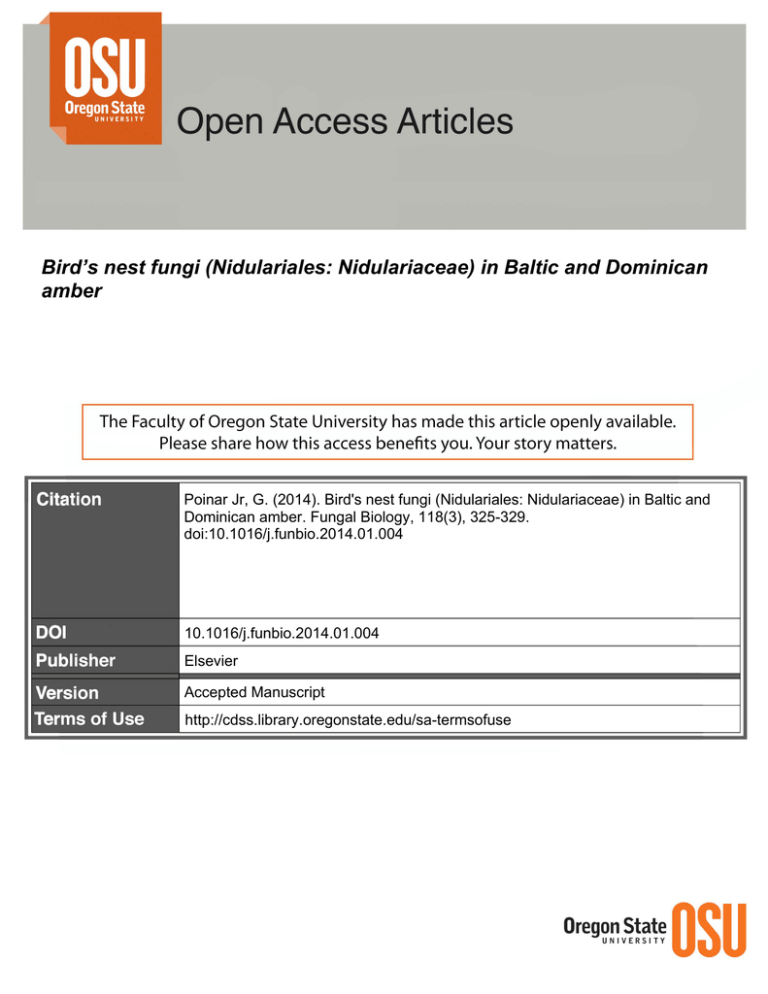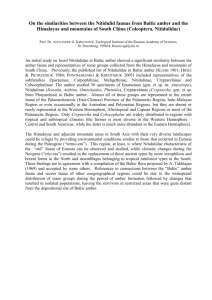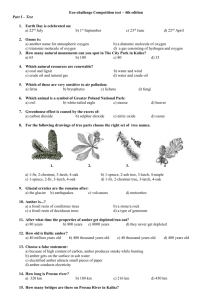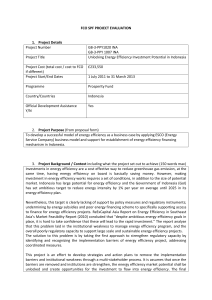Bird’s nest fungi (Nidulariales: Nidulariaceae) in Baltic and Dominican amber
advertisement

Bird’s nest fungi (Nidulariales: Nidulariaceae) in Baltic and Dominican amber Poinar Jr, G. (2014). Bird's nest fungi (Nidulariales: Nidulariaceae) in Baltic and Dominican amber. Fungal Biology, 118(3), 325-329. doi:10.1016/j.funbio.2014.01.004 10.1016/j.funbio.2014.01.004 Elsevier Accepted Manuscript http://cdss.library.oregonstate.edu/sa-termsofuse Bird’s nest fungi (Nidulariales: Nidulariaceae) in Baltic and Dominican amber George Poinar, Jr. Department of Zoology, Oregon State University, Corvallis, OR 97331 USA E-mail: poinarg@science.oregonstate.edu Tel: 541 760 7319 Fax: 541 757 1639 Running title: Nidulariaceae in amber Abstract: Nitula baltica sp. nov. and Cyathus dominicanus sp. nov. are described from Cenozoic Baltic and Dominican amber. These are the first fossil members of the Family Nidulariaceae and show that the basic characteristics of this group were already established some 40-50 million years ago. Keywords: Bird’s nest fungi, Cenozoic Nidulariaceae, amber fossils 1. INTRODUCTION While examining inclusions in samples of amber from the Baltic area and the Dominican Republic, two small bird’s nest fungi of the family Nidulariaceae were discovered. In this group, spores are produced in small packets (peridioles) borne at the base of various shaped receptacles. Spore dispersal is effected by a splash-cup mechanism with raindrops dislodging the peridioles into the adjacent area. A recent study detailed the 1 ejection of the peridioles and the behavior of the funicular cord that was first condensed but then became extended to allow its adhesive surface to encounter various obstacles in the environment (Hassett et al. 2013). The present fossils show that this unique method of spore dispersal was established at least by the Eocene, some 40-50 million years ago. The present study describes these specimens and compares them with extant members of the Nidulariaceae. 2. MATERIALS AND METHODS The descriptions presented here are based on two complete and well-preserved specimens in Dominican and Baltic amber, respectively. The Baltic amber specimen was obtained from mines in the Kaliningrad region of Russia. Baltic amber is considered to vary between 40 and 50 million years (Larsson 1978; Poinar 1992). The Dominican amber specimen was obtained from mines in the Cordillera Septentrional of the Dominican Republic. Dating of Dominican amber is still controversial with the latest purposed age of 20-15 mya based on foraminifera (Iturralde-Vinent & MacPhee 1996) and the earliest as 45-30 mya based on coccoliths (Cêpek in Schlee 1990). A range of ages for Dominican amber is possible since the amber is associated with turbiditic sandstones of the Upper Eocene to Lower Miocene Mamey Group, thus indicating re-disposition (Draper et al. 1994). Dominican amber was produced by the leguminous tree, Hymenaea protera Poinar, and a re-construction of the Dominican amber forest based on amber fossils indicated that the environment was similar to that of a present day tropical moist forest (Poinar & Poinar 1999). The amber pieces were re-polished to obtain 2 detailed photographs of the lateral and apical surfaces. Each specimen contained a single peridiole at the base of the peridium. It was not possible to section the peridioles without destroying the specimens. Observations and drawings were made with a Nikon SMZ-10 stereoscopic microscope. 3. RESULTS Taxonomy The structure of the fossils with the funnel-shaped fruiting bodies (peridium) resembling a birds’ nests with an egg (peridiole) inside closely resembles the condition found in extant members of the Nidulariaceae. Description of the fossils follows the traditional classification based on shape, size, color, etc. since molecular data is unavailable. Because there is no evidence of an epiphragm covering the peridial opening and both fossils contain a single peridiole, they are considered to be mature specimens. Baltic amber specimen Phylum: Basidiomycota Family Nidulariaceae Nidula V.S.White, 1902 This specimen is placed in the genus Nidula because of its uniform, two-layered peridium wall, the absence of a funicular cord attaching the peridioles to the peridium wall and a gelatinous deposit surrounding the peridiole. Nidula baltica Poinar sp. nov. (Figs. 1, 2) 3 Description Peridium: Dark brown, narrowly obconic, vase-like with mouth flaring outward, nonplicate, 2.7 mm high and 1.1-1.2 mm wide at the mouth, stipe absent; two layered wall formed from small, flattened, smooth, overlapping hair-like scales 80 µm - 130 µm in length and 90 µm-110 µm in width; apical rim surrounded by series of larger, upturned, exposed scales ranging from 125 µm to 190 µm in length. Peridiole: Dark brown, subspherical, surface 380 µm x 320 µm; purse not present; situated in jelly-like deposit; basidiospores not visible. Holotype: Deposited in the Poinar amber collection (accession # AF-9-20B) at Oregon State University. Etymology: Based on area of origin (Baltic region). Type locality: Amber from the Kaliningrad region of northern Europe. Diagnosis: This specimen is placed in the genus Nidula V.S.White because of its uniform, two-layered peridial wall, the absence of a funicular cord attaching the peridioles to the peridial wall and a gelatinous deposit surrounding the peridiole. Except for the apical rim surrounded by exposed scales, the shape of the fossil is similar to that of the Chilean species, N. macrocarpa. However the latter species is much larger than N. baltica, has a homogenous peridial wall and lacks the apical rim of exposed scales (Brodie 1975; Diehl 2000). The small size and apical rim of scales distinguishes N. baltica from other members of the genus (Brodie 1975, 1977). Dominican amber specimen Phylum: Basidiomycota 4 Family Nidulariaceae Cyathus Haller, 1768 Cyathus dominicanus Poinar sp. nov. (Figs. 3-5) Peridium: Narrowly obconic, funnel-shaped, not flaring out at mouth, with three-layered non-plicate walls and short slender stipe 320 µm in length; outer peridial wall with outward pointing hairs; length, 1.8 mm, width at mouth, 650 µm; setae absent. Peridiole: Brown, oval, surface diameter, 265 µm x 180 µm; thickness, 140 µm; attached to peridial wall by purse, thus implying presence of a funicular cord; basidiospores not visible; remains of at least 5 other torn purses present in basal area of peridium (Fig. 5). Holotype: Deposited in the Poinar amber collection (accession # AF-9-20A) at Oregon State University. Etymology: Based on country of origin (Dominican Republic). Type locality: Amber from mines in the Cordillera Septentrional, Dominican Republic. Diagnosis: This specimen is described in the genus Cyathus because of the three- layered peridial wall and presence of a purse indicating a funicular cord. The peridioles of Nidula do not have a funicular cord and the peridium of Crucibulum is cup or crucibleshaped, composed of a single layer and the peridioles are whitish (Brodie 1975; Miller and Miller 1988). In his key to the species of Cyathus (Brodie 1977), C. dominicanus comes closest to members of Group ll, the palidus group, containing C. pallidus Berk. & Curt and C. julietae Brodie, both of which occur in the West Indies. This group is characterized by non-plicate, light-colored peridia with fine, matted hairs not flaring out abruptly at the mouth. In their key to the Brazilian species of Cyathus, the peridial shape 5 of C. stercoreus (Schw.) resembles that of C. dominicanus. However, their specimens of C. stercoreus ranged from 10-13 mm in length and the peridioles ranged from 1.5-2.0 mm in diameter, which are much larger values than the corresponding features on the fossil (1.8 mm in length and 265 µm x 180 µm for the peridioles)(Baseia & Milanez 2001). A short basal stipe similar to that on C. dominicanus occurs on other members of the genus Cyathus, such as C. triplex Lloyd, C. gracilis Brodie and C. montagnei Tul. et C. (Brodie 1975; Trierveiler-Pereira & Baseia 2013). Only C. microsporus Tul. has previously been reported from Hispaniola (Brodie & Dennis 1984). This species, which can also have a fawn peridium, is 4-7 mm in length and about 6 mm wide at the mouth, which separates it from C. dominicanus. The length of the peridium (under 2 mm), narrow apical opening separates C. dominicanus from all extant members of the genus (whose peridia range from 4 mm to 18 mm in length) (Brodie 1975, 1977, 1984; Trierveiler-Pereira & Baseia 2013; Miller & Miller 1988). 4. DISCUSSION The Nidulariaceae is a unique group that appears to be nestled within the euagarics but actually has no close connection with any fungal family (Hosaka et al. 2006). The present study shows that the basic morphological features of the Nidulariaceae were already established by the mid-Cenozoic. The state of preservation of both fossils is excellent and the morphological characters appear unaltered. The pristine condition of amber fossils is thought to be the result of fixation of the tissues from chemicals contained in the original resin. In amber embedded arthropods, there is often some collapsing of the appendages due to 6 dehydration, which is also an important part of the preservation process. However, with fungi in fossilized resin, it is rare to find any sign of dehydration or collapsing of the tissues. For instance, even the pileus of the Early Cretaceous Myanmar amber agaric, Palaeoagaracites antiquus Poinar & Buckley (2000) that must have been extremely fragile since it was partly decomposed by a mycoparasite, showed no signs of preservation distortion. Even spores are retained on phialides in recognizable form as shown in the Early Cretaceous Myanmar amber Hypocreales, Paleoophiocordyceps coccophagus Sung, Poinar & Spatafora (2008) that was parasitizing a scale insect. Mature fruit bodies of present day species of Cyathus and Nidula contain numerous peridioles prior to a dispersal event. Normally the peridioles are either full or empty, as a result of a dispersal event. It is unusual to find a single peridiole remaining inside the fruit bodies after a dispersal event as observed in these fossils (Brodie 1975). The remaining single peridiole in both fossil species may be related to the how the fruiting bodies were preserved. Falling in resin may have ejected all but the basal peridiole. Normally in extant forms, the funicular cord is only visible after dissection of the sheath, purse, and peridiole. Thus, in C. dominicanus, the presence of a funicular cord is based on the presence of a purse (Brodie 1956). When the peridium is splashed by a raindrop, the purse is torn, and peridioles are liberated with the funicular cord coiled on the underside. The cord is only visible when the hapteron is physically pulled out from the underside of peridioles, or in nature, when a peridiole strikes an obstacle during a dispersal event (Hassett et al. 2013; Brodie 1956). 7 It is curious how these two bird’s nest fungi arrived in amber. It is likely that both fossils were growing on a dead branch of the resin-producing trees and after becoming dislodged, possibly by some animal, fell into a pool of resin that had collected on one of the lower branches. Brodie (1975) mentions that bird’s nest fungi occur on twigs and branches in forests, which would then explain the above scenario. 5. CONCLUSIONS The fossil Bird’s Nest Fungi reported here show that the group had already diversified by the middle of the Cenozoic and probably date back to the Cretaceous. Acknowledgments Thanks are extended to Roberta Poinar and Art Boucot for editorial comments. REFERENCES Baseia IG, Milanez AI, 2001. Cyathus (Gasteromycetes) in areas of the Brazilian Cerrado Region, São Paulo State. Mycotaxon 80: 493-502. Brodie, HJ, 1956. The structure and function of the funiculus of the Nidulariaceae. Svensk Botanisk Tidskrift 50: 142-162. Brodie HJ, 1975. The Bird’s Nest Fungi. University of Toronto Press, Toronto. Brodie HJ, 1977. A key to the species of Cyathus (Nidulariaceae). Botaniska Notiser 130: 453-459. 8 Brodie HJ, 1984. More Bird’s Nest Fungi (Nidulariaceae). A supplement to “The Bird’s Nest Fungi (1975). Lejeunia 112: 1-69. Brodie HJ, Dennis RWG, 1954. The Nidulariaceae of The West Indies. Transactions of the British Mycological Society 37: 151-160. Diehl P, 2000. Anatomy of the peridium in the genus Nidula (Nidulariales, Basidiomycetes). Sydowia 52: 16-29 Draper G, Mann P, Lewis JF, 1994. Hispaniola, In: Donovan S, Jackson TA, editors. Caribbean Geology: An Introduction. Kingston: The University of the West Indies Publishers' Association. p. 129-150. Hosaka K, Bates ST, Beever RE, Castellano MA, Colgan W, Dominguez LS, Nouhra ER, Geml J, Giachini AJ, Kenney SR, Simpson NB, Spatafora JW, Trappe JM, 2006. Molecular phylogenetics of the gomphoid-phalloid fungi with an establishment of the new subclass Phallomycetidae and two new orders. Mycologia 98: 949-959. Iturralde-Vinent MA, MacPhee RDE, 1996. Age and Paleogeographic origin of Dominican amber. Science 273:1850-1852. Hassett MO, Fischer MWF, Sugawara ZT, Stolze-Rybczynski J, Money NP, 2013. Splash and grab: Biomechanics of peridole ejection and function of the funicular cord in bird’s nest fungi. Fungal Biology 117: 708-714. Larsson SG, 1978. Baltic amber- a Palaeobiological Study. Entomonograph 1: 1-192. Miller HR, Miller OK ,1988. Gasteromycetes: Morphological and developmental features, with keys to the orders, families and genera. Eureka, California, Mad River Press 1-71pp. Poinar Jr GO, 1992. Life in Amber. Stanford Univ. Press, Stanford, CA. 9 Poinar Jr GO, Poinar R, 1999. The Amber forest. Princeton University Press, Princeton. Poinar Jr GO, Buckley R, 2000. Evidence of mycoparasitism and hypermycoparasitism in Early Cretaceous amber. Mycological Research 111: 503-506. Sung G-H, Poinar Jr G O, Spatafora JW, 2008. The oldest fossil evidence of animal parasitism by fungi supports a Cretaceous diversification of fungal–arthropod symbioses. Phylogenetics and Evolution 49: 495- 502. Schlee D, 1990. Das Bernstein-Kabinett. Stuttgarter Beiträge zur Naturkunde (C). No.28, 100 pp. Trierveiler-Pereira L, Baseia IG, 2013. Cyathus species (Basidiomycota: Fungi) from the Atlantic Forest of Pernambuco, Brazil: taxonomy and ecological notes. Revista Mexicana de Biodiversidad 84: 1-6. FIGURES Fig. 1. Lateral view of peridium of Nidula baltica in Baltic amber. Bar = 580 µm. 10 Fig. 2. Top view of peridium of N. baltica in Baltic amber. Note rim of overlapping scales and peridiole at base of peridium. Bar = 380 µm. Fig. 3. Lateral view of peridium of C. dominicanus in Dominican amber. Fig. 4. Top view of peridium of C. dominicanus in Dominican amber. Note three-layered wall of peridium with mesoperidium showing as a dark band. Bar = 265 µm. Fig. 5. Lateral view of C. dominicanus with special lighting. Left arrow = peridiole; right arrow = torn purse/sheath from previously ejected peridioles. Bar = 300 µm. 11



